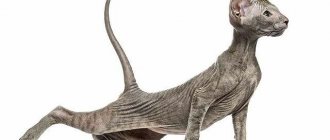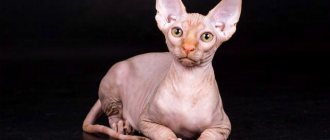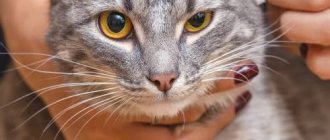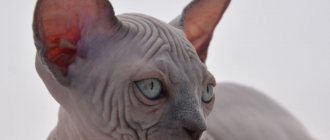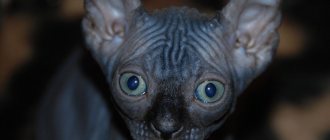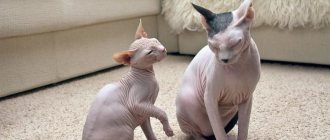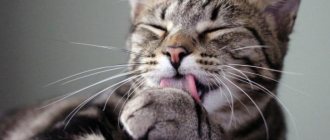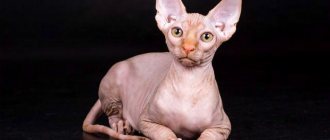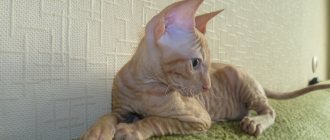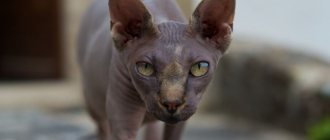LiveInternetLiveInternet
—Categories
- Cooking (1681)
- Miscellaneous (189)
- Everything for the blog (186)
- postcards (56)
- frames (42)
- backgrounds (25)
- dividers (22)
- avatars (14)
- emoticons (1)
- Health (90)
- Beauty (85)
- Photos (76)
- Poems, aphorisms, parables (61)
- Handicrafts (61)
- Photoshop (59)
- scrap kits (15)
- clipart (11)
- lessons (8)
- frames (4)
- calendars (3)
- styles (3)
- plugins (1)
- Holidays and gifts (47)
- India (34)
- Useful programs (16)
- Optimization and promotion (12)
- Videos (11)
- Music (11)
- Blog Schemes (11)
- Fashion (8)
- humor (7)
- Attracting wealth (7)
- Flowers (2)
-Video
-Music
—Search by diary
—Subscription by e-mail
-Statistics
Basics of proper nutrition
There are no special rules that must be followed when composing the diet of the Canadian Sphynx. These cats eat the same things as their “woolly” relatives. But for a novice cat owner, we will repeat the basic rules for feeding a pet.
Choose the food that is most suitable for your cat: Kitiket, Purina, Hills, FortiFlora, Royal Canin.
Kitten
According to generally accepted international standards, a kitten can be separated from its mother no earlier than 12 weeks after birth.
At this age, the young animal has already fully mastered the skills of independent feeding and most likely copes well with regular “adult” cat food (if you have ever seen how three-month-old kittens living with their mother behave, you will understand that feeding them something one thing, and an adult cat something else - a useless idea: they will still steal from each other’s plates).
Thus, when purchasing a Sphynx kitten, you do not need to select a special “children’s” diet for it. Almost the only difference in the diet of such a baby and an adult cat is the number of meals per day.
A kitten aged three to five months is recommended to be fed four to five times a day, then one or two feedings are gradually skipped, and starting from nine months, just as gradually, the young animal is transferred to two meals a day, which continues throughout its life.
Never leave uneaten food on a plate. Clean up mercilessly until next time! The only exception in this regard is dry food; it can be present in the feeder around the clock, provided that the cat has access to a large amount of fresh, clean water.
If you are going to use cat food in your animal’s diet, give preference to those specially designed for kittens (they are present in the line of almost all well-known brands). Only super premium and premium food is suitable for Sphynx cats.
If you are more satisfied with natural food, you will need to add vitamins to the usual diet for all cats, this will allow you to achieve the necessary balance of all the nutrients the animal needs.
Adult cat
So, we feed kittens almost the same way as an adult cat, only more often. Here the rules are as follows.
Food can be of two types - special ready-made food or natural food. The choice is up to the owner, but it must be made before purchasing a kitten, so as not to injure the animal by throwing from side to side.
Combining different types of food is allowed, but it is better to do this not within one meal. And under no circumstances is “food from your table” suitable for a cat.
Cats are carnivores, so the basis of their diet is meat (or fish). Pets can be fed with poultry, rabbit, beef and veal; pork, sausages and other preserved and semi-finished products are prohibited.
Meat and fish (sea, lean, boneless) can be boiled or raw, offal - only boiled.
Your cat will sell its soul for a piece of raw meat, so you shouldn’t deny the animal such a pleasure, but first the product must be either frozen or doused with boiling water, otherwise the cat runs the risk of “catching” helminths.
In addition to meat, cats can (and need): low-fat milk and dairy products, boiled chicken or quail eggs (the latter do not need to be boiled, just scattered in a plate), vegetables, herbs, boiled cereals. Potatoes are prohibited. You shouldn't get carried away with legumes either.
Don't let your pet overeat, especially since Sphynx cats often suffer from obesity.
Important! The lack of hair leads to the fact that the Canadian Sphynxes are always cold. As a result, metabolic processes in their bodies are somewhat faster than those of other cats, and accordingly, they are constantly hungry.
The owner needs to be especially attentive to how much his pet eats, and not give in to the cat’s pleading gaze. The point is not only that the fat Canadian Sphynx is simply a disgusting sight.
Excess weight is truly harmful to the health of the animal; such cats live much shorter than their lean counterparts.
How to choose the right Sphynx kitten
Little sphinxes are demanding and gentle children.
In order for a Sphynx kitten to grow up healthy and its development to be complete, the baby’s diet must be varied and balanced: professional food only of Super Premium class, special vitamins and supplements, canned food for kittens, it is advisable to feed raw frozen meat, chicken, baby food. It is very important that kittens can communicate with people as often as possible, starting from the very first days of life, because this is the key to the fact that the kids will grow up affectionate, sociable and human-oriented. Left to its own devices, a small sphinx, deprived of human attention and affection, like an abandoned child, can grow up withdrawn and unsociable, with various behavioral and mental disorders. When you come to choose a Canadian Sphynx, be sure to pay attention to the behavior of the kitten: pet it and see how the baby responds - purrs, arches its back with pleasure, caresses, plays with you in response - this is exactly how a “correct” Sphynx should behave.
Under no circumstances should the kitten show any signs of aggression - hiss, avoid you and try to hide, extend its claws.
Good breeders castrate/sterilize their kittens in advance, before the babies go to a new home, but this does not mean that the kittens are of low quality, much less have any defects. Acquiring producers of valuable bloodlines is a very troublesome and expensive matter; a stable show type of animals in the nursery is formed over the years thanks to the breeder’s clearly structured breeding program, and it is quite natural that the breeder strives to protect good bloodlines from “breeders” and “thirst for easy money” buyers . If you are really buying a Sphynx for the soul, then it is more profitable to take an already castrated baby, this way you will avoid the “surprises” of puberty in the maturing animal and the need to undergo this operation in the future. In Europe and the USA, many years of experience have been accumulated indicating that early castration/sterilization does not have any negative effect on the development of animals; however, at an early age, kittens tolerate anesthesia and the operation itself more easily, and the healing process goes faster.
Be wary if the breeder is not interested in who you are, for what purpose you are buying a Sphynx kitten, or in what conditions it will live; if the breeder is ready to sell you a non-neutered kitten with all the documents without asking any unnecessary questions. Kittens raised with love and according to all the rules are always full-fledged members of the family and beloved little ones, so a good breeder is ALWAYS interested in what conditions the kitten will live in and takes part in its future fate. Pay attention to the number of animals living in an apartment (house) at the same time; crowding is dangerous due to the emergence and constant recurrence of viral and infectious diseases.
Never adopt a kitten before 3 months of age. The mother cat feeds the kittens up to 1.5-2 months, and she also teaches them the basics of behavior: how to eat food and lap water correctly, lick themselves, use a litter box, and communicate with each other. Kittens that grow up in a “family” for at least 3 months have a more stable psyche, they are better adapted to the environment, and adapt more easily to a new home. In addition, the last vaccinations are completed by approximately 2.5 months of age. After the last vaccination, you must undergo a short quarantine of 1-2 weeks so that the breeder can make sure that the vaccination has gone well and there are no negative consequences for the kitten.
There is a legend among buyers that the older the kitten, the more difficult it is for it to get used to its new owners. However, this opinion is not true. All features of behavior and adaptation are associated not with the age of the kitten, but with its individual temperament, which, even over the years, remains virtually unchanged among Canadian Sphynx cats.
Do you want to give a kitten to your child for his birthday? Then right now go to the site where you can buy kittens at very competitive prices or receive them as a gift. Visit the website and choose for yourself!
If you want to find out how Bali is located on the world map, I advise you to visit the website Tourister.ru!
Personality Traits of Canadian Hairless Cats
Sphynx cats have a very kind, patient character and good attitude towards dogs. These cats can be left alone with children without worrying about both of them. They are not jealous, very patient and smart. Sphinxes often choose their favorite owner or even guest.
Male Sphynx cats tend to be dominant. They consider themselves masters of the house, independent and very curious. Any event does not pass by, any thing will be studied. Cats are softer and more gentle. They easily gain the trust and love of their owner. But the females need more attention to themselves and do not let you forget about their person: they will chase you and lick your face until they get tired. Female sphinxes are great lovers of cleanliness. They can lick themselves for hours. The completed washing procedure can be repeated after 2–3 hours.
Many people think that Canadians are very aggressive. But this is a mistaken opinion. My parents have a Canadian Sphynx. And he is very friendly, active and not afraid of strangers. Sphinxes have developed intelligence.
You can leave the Canadian Sphynx with the child
Positive qualities and disadvantages of the breed
Like any animal, the Canadian Sphynx has both positive and negative properties.
The positive qualities include the fact that they:
- playful;
- active;
- curious;
- tender;
- affectionate to the owner;
- get along well with other animals;
- patient;
- smart;
- love children.
And the negative qualities are as follows:
- they need daily care and frequent bathing;
- afraid of the cold;
- may seem intrusive.
Video: interesting facts about the Canadian Sphynx
Basic moments
- In the world, the breed is known simply as Sphynx - Sphinx; in Russia, the adjective “Canadian” is added to avoid confusion with the Don and St. Petersburg (Peterbald).
- Contrary to popular belief, Sphynx cats are not hypoallergenic, since unpleasant symptoms in people prone to allergies are caused not by fur, but by components of saliva and sebaceous gland secretions.
- Cats are famous not only for their unusual appearance, but also for their incredible affection for their owners; they love attention and affection, and have difficulty enduring loneliness.
- They need regular and careful care and protection from adverse environmental factors.
- They get along well with other cats and even dogs, but an ideal companion would be a second representative of the same breed.
- It is preferable to keep Sphynxes at home.
- Excellent appetite is compensated by fast metabolism.
- The average life expectancy is 10-14 years, although long-livers are also known, whose age was 16-19 years.
The Canadian Sphynx is a loving and sociable pet that easily wins the hearts of people who care about cats. The owners of these animals unanimously say that they would never exchange them for representatives of other breeds. For their large ears, expressive eyes and folds of skin on their faces, sphinxes received the affectionate nickname “aliens.”
Features of caring for hairless cats
Caring for Canadian Sphynx cats does not involve anything special or difficult. Bathing, cleaning ears and eyes, and trimming nails should be regular.
In the cold season, you need to dress the sphinx in warm clothes and monitor the temperature in the room.
Due to the lack of hair, Sphynx cats are often cold and can catch a cold in a draft, so you should take care of special clothes for them.
Bathing
Sphynxes should be bathed as their skin becomes dirty and as rarely as possible. Too frequent procedures can lead to excessive dryness of the skin, and too infrequent procedures can lead to clogged pores, accumulation of secretions in the folds of the skin and, as a result, skin diseases. In summer, the animal is bathed no more than once a week, and in winter - when dirty.
Shampoo for hairless pets should be hypoallergenic, with a neutral pH of 5.5. It is advisable to purchase a detergent designed specifically for sphinxes:
- Ms.Kiss “Graceful Sphinx”;
Shampoos developed for hairless cats take into account the characteristics of the animal’s skin.
- "Elite professional" from "Agrovetzaschita".
The water for bathing should be quite hot: about 37–38˚С. Swimming in cool water often leads to colds. After the procedure, you need to wipe your pet with a dry soft towel. You cannot blow dry cats of this breed, as the skin will react negatively to dry hot air. The temperature in the room after water procedures should be no lower than 25˚C. Otherwise, the animal may catch a cold.
Caring for ears, eyes, claws
It is necessary to carefully clean the ears with slightly damp cotton swabs as they become dirty. To prevent eye diseases, you need to clean your eyes once a week with a cotton pad moistened with boiled water or weak tea leaves. And also regularly (once every 10-14 days) cut the nails.
Typically, Sphynx cats do not resist when performing these simple actions. On the contrary, many of them love to lie with their owner in a warm bath and purr loudly when their nails are trimmed after bathing.
Video: how to care for the Canadian Sphynx
Toilet
Most often, a special plastic tray is used for the toilet. When purchasing it, make sure that the dimensions allow your pet to fit comfortably in it. It should be taken into account that when the kitten grows up, it is not advisable to change the toilet to which he is accustomed to a larger tray. You also need to correctly select the height of the sides of the litter tray. From a litter box with low sides, litter may spill out, and a tray with high walls may be uncomfortable for the kitten. It is advisable for the toilet to have a flat bottom. This gives it stability.
Diet of the Canadian Sphynx
Feed your pet only high-quality food and products. The Canadian Sphynx can be fed with both ready-made food and natural products.
Ready-made feed
Ready-made food can be dry or wet. Any of these species can be used to feed Sphynx cats. Some veterinarians recommend using a mixed type of feeding, when the cat's diet includes both dry and wet food. But other experts are opponents of this approach. In any case, it would be wise to consult with your veterinarian or the breeder from whom you are purchasing the kitten about what is best to feed your pet.
Economy class products are not suitable for feeding Canadian Sphynx cats. They are not able to meet the body's needs for essential substances and can even harm the pet's health. Therefore, it is necessary to buy only premium or super premium food. These include:
- HILLS (Hills);
- EUKANUBA (Ekanuba);
- EAGLE PACK (Eagle Pak);
- IAMS (Yams);
- ROYAL CANIN (Royal Canin);
The Royal Canin brand has dry food specially designed for Sphynx cats
- NUTRO CHOICE (Nutro choice);
- BOSH (Bosch);
- PRO NATURE (About Nature);
- PRO PLAN (Pro Plan);
- INNOVA (Innova);
- CHIKEN SOUP (Chicken soup);
- ACANA (Akana);
- ORIJEN (Origin).
Natural products
The diet of an adult Sphynx should include the following foods:
- lean meat;
- chicken kidneys and hearts;
- fish;
- cereal;
- vegetables;
- greens and fruits (if the animal does not mind this).
The following products are prohibited:
- fish bones;
- milk;
- raw river fish;
- chicken bones;
- salty foods;
- smoked meats;
- sweets;
- spicy foods.
A small kitten up to 1.5 months should be fed with mother's milk. Then the diet includes:
- cottage cheese;
- egg yolk;
- milk formulas;
- porridge.
From three months you can give:
- greenery;
- unsalted cheese;
- boiled lean beef;
- boiled vegetables;
- shredded chicken breast.
The power mode is as follows:
- from 1 to 3 months you need to feed the kitten 6–8 times a day, 20 or 25 g per feeding;
- from 4 to 6 months - 2-3 times a day, 40 or 50 g per feeding.
History of the Canadian Sphynx breed
Although the breed is quite young, the existence of hairless cats is mentioned in the annals of various civilizations. The thing is that “bald” offspring can appear from completely ordinary parents as a result of a natural mutation. Most often, such animals were considered an anomaly and were discarded by humans.
There is evidence of the emergence in South America of an entire population of graceful creatures with amber-colored eyes. True, unlike Canadians, they could be partially covered with wool during the cold season, and wore mustaches all year round. It is impossible to judge the genetic characteristics of these animals today, since the breed has disappeared. The last individuals whose existence is documented lived in the 20s of the last century, but then “Inca cats,” as the Mexicans called them, did not interest professional breeders.
40 years have passed, and much further north, in the Canadian province of Ontario, the owner of a black and white short-haired cat named Elizabeth was surprised to find an unusual specimen in her pet’s litter. The kitten was given the name Prune (English: Prune) and, upon reaching maturity, was crossed with its own mother. The first experiments seemed successful, but already in the early 1970s the line was interrupted.
Around the same time, a new stage in the history of the breed began. In one of the catteries in Baden, Minnesota, two cats were devoid of fur at once. All modern elite lines trace their pedigree back to them, although the selection process, of course, included cats of different breeds. The best results were achieved by working with Devon Rexes; “naked” kittens, which were again discovered among our northern neighbors, actively participated in the creation of the breed. They were originally called “Canadian hairless cats,” but enthusiasts wanted something more sonorous and drew parallels with the oldest surviving monumental sculpture - the Egyptian Great Sphinx, which guards the peace of ancient rulers in Giza.
Recognition from international felinological organizations did not come immediately. There were concerns that the mutation was causing serious health problems. When time showed the inconsistency of these theories, The International Cat Organization (TICA) was the first to allow Sphynx dogs to participate in its exhibitions in 1986. After 6 years, champion status was received from the Canadian Cat Association (CCA), but the breed standard according to the authoritative The Cat Fanciers' Association (CFA) was approved relatively recently, in 2002.
Description and characteristics of the breed
The Canadian Sphynx is a relatively young breed, its “age” is about 50 years (due to the rather complex history of the official recognition of this breed by various felinological organizations, it is difficult to name the exact date of its birth). Sphinxes came to Russia and, accordingly, to other countries formed after the collapse of the USSR quite recently, already at the beginning of this century. But if fifteen years ago a hairless cat caused horror and disgust, today such a pet will not surprise anyone.
And this is not surprising. They say that once a person has hugged the warm and completely defenseless body of this cat, a person can no longer part with it. In any case, for a long time.
Breeds such as the Siamese cat, Burmese cat, and Cornish Rex are also especially sensitive to warmth.
External characteristics
There are several breed standards for the Canadian Sphynx: CFA, TICA, WCF. The differences in these standards, at least from the point of view of the common man in the street, are not so noticeable, nevertheless they exist.
Since the World Cat Federation (WCF) is the most widespread in Europe, in the further description of the appearance and character of a cat we will be guided mainly by the approach of this particular organization.
Life expectancy: 13-15 years.
Litter: 3-6 kittens.
Colors: any, but most often white with a pinkish tint, as well as piebald.
Wool: none.
Leather: thick, suede-like.
Size: medium, with cats being much larger than cats.
Weight: on average 3.5 kg for a cat, 5 kg for a cat.
Recognized by: WCF, TICA, ACFA, ACA, AACE, CCA, CFA, FIFe.
The Canadian Sphynx has a strong body of medium size. The bones should not be heavy, although the chest is quite broad and massive, making the front legs clearly set wide apart.
The belly is rounded, the legs are graceful but strong. The toes are long, the tail is thin, long and hairless; only the presence of a small tassel at the end is not considered a fault.
The head has the shape of a slightly rounded wedge (longer than width). The head size is average. A characteristic feature of the Sphynx is a powerful short muzzle with clearly defined protruding cheekbones; the transition is clearly visible in profile. The neck is neither long nor short, but rather strong.
The ears are also the hallmark of the breed. Very large, wide in fit and in size at the base. The fur on the outside is completely absent, with the exception of a possible fluff at the very base.
Huge, slightly slanted and fairly wide-set almond-shaped eyes can be of any color that harmonizes with the base color.
Canadian Sphynx cats have virtually no fur. Their skin is covered only by invisible fluff, almost the same as that of humans.
Short fluff is present only on the muzzle. “Whiskers” and “eyebrows” (correctly called “vibrissae”) are welcomed in the WCF standard, while in other international organizations it is considered that sphinxes should not have such hair, or they may be broken off or very short.
All accepted standards say that Canadians can have any color, however, the CFA in this regard makes an additional requirement: the hair on the cat’s body should not have zonal coloring, accordingly, there should be no smokiness, chinchilla-like appearance, or cameos among the sphinxes.
And finally, perhaps the most important thing that, in addition to the lack of hair, makes the Sphynx a Sphynx - the characteristic folds on the skin. They should be present on the neck, on the legs and even on the forehead.
In small kittens, almost the entire body is “wrinkled”; with age, most of the folds smooth out, but they should still be clearly visible. The CFA standard states that the maximum number of folds is encouraged, as long as they do not interfere with the animal.
Aggression and “bad manners” are considered a disadvantage. WCF and TICA reject animals that are too similar to the Cornish Rex, Devon Rex or Oriental; CFA reduces marks for lack of folds, small size, excess hair on the paws, and “wrong” bones.
Character and habits
Sphynx cats are sometimes called "moon" or "alien" cats. And the point here is not only in the completely unique appearance, but also in the character of these stunning creatures.
Did you know? Canadian Sphynxes became famous thanks to the films “Star Wars”, “E.T. the Extra-Terrestrial”, “Austin Powers”. American fans of this breed even dedicated a separate printed publication to it. The newspaper is called "The Naked Truth".
They say that the Canadian Sphynx has something of a cat, something of a monkey, something of a dog and something of a child: these cats love various acrobatic tricks, are devoted to their owner like a dog, are positive and playful, like children , and at the same time remain cats - with their inherent grace, mystery, independence and charm.
Unfortunately, this is in theory. In practice, many Sphynx owners not only do not observe anything canine in their pets, but they also do not always notice feline traits as such.
Often, communication between such a cat and its owner comes down only to the process of feeding (and these animals have an excellent appetite, and this, alas, is not due to a good life). Yes, Canadians are very affectionate and happily climb into their owner’s lap or under a blanket, but who knows? - perhaps they are simply using a person as a heating pad.
Such diametrical characteristics in character descriptions are not often found in the cat world.
Perhaps it has to do with the individual characteristics of this or that animal (this means that the character of the Canadian Sphynx can be anything), or perhaps it is simply very important to create the right conditions for this unusual cat, and this, taking into account how it was created breed, it’s not so easy to do.
Most often, cat breeds chosen as pets include Exotic Shorthair, Persian, Thai, Russian Blue, and British Shorthair.
Appearance of the Sphinx
Sphynxes are not among the large breeds. Females usually weigh 3.5-4 kg, males weigh between 5-7 kg. At the same time, the body is muscular and dense, which is why cats actually turn out to be heavier than one might expect given their size. The skin is thick and gathers into characteristic folds, especially pronounced on the muzzle.
Head
Medium in size, shaped like a slightly rounded modified wedge, where the length is slightly greater than the width. The forehead is flat, the transition from it to the muzzle can be either quite soft or clearly pronounced. The muzzle is short. The cheekbones are high and clearly defined. The chin is strong and forms a perpendicular to the upper lip. The nose is short, with a slight to medium stop. The whisker pads are well developed, although the whiskers themselves are completely or almost completely absent.
The best conditions for a cat
The Canadian Sphynx does not require special care, and yet its maintenance is associated with some peculiarities.
Due to the lack of hair, this breed is generally considered hypoallergenic, but people who have an allergic reaction to cats should still first make sure that the disease does not manifest itself when interacting with the Sphynx.
For the same reason, such cats have many other advantages: they do not shed, they do not require painful cleaning of carpets and upholstered furniture, and they do not need to be combed for a long time.
However, you have to pay for everything. Hairless cats begin to freeze even when the temperature in the apartment seems completely comfortable for humans.
When caring for a cat, it is important to know how to train a cat to use a litter box, whether a cat needs clothes, how to wash a cat at home, all the pros and cons of sterilization, how to choose a comfortable carrier, how to get rid of the smell of cat urine, how to mate cats correctly.
For this reason, be sure to take care of a warm nest for your pet and be prepared for the fact that he will spend whole days there, desperately suffering and not meeting the expectations of getting a sociable and cheerful cat.
As a good way out of the situation, you can try to dress the animal in a smart padded jacket or pajamas (for Canadian Sphynxes, clothing is a necessity, not a whim of the owners), but not all cats are favorable to such treatment.
But a too hot climate is also unacceptable for the Canadian Sphynx.
Therefore, before choosing this breed, carefully weigh all the pros and cons, soberly assess the average annual temperature parameters inside your home, consult with specialists (not those from whom you are going to buy a kitten) and only then make a decision.
Did you know? Many sources say that the body temperature of the Sphynx is higher than that of a “regular” cat. Actually this is not true. Although, holding your tender body close to you, it seems unusually hot to you, this is nothing more than an illusion. The fact is that cats’ body temperature is generally two degrees higher than that of humans, but when you come into contact with hairless skin, you subconsciously form an association with a person, which is why the brain signals to you: the temperature is very high!
Care and maintenance
Canadians require increased attention from their owner. Due to increased body temperature, cats sweat a lot, so they need to be washed regularly, every 14–30 days, with a special shampoo.
The Sphynx's eyes also require regular care. The absence of eyelashes allows dust to get into them, which can cause inflammation. To prevent this from happening, wipe your eyes daily with a special lotion.
Another important procedure is nail trimming. Use sharp nippers or nail scissors to cut off the very ends every 20–30 days. If this is not done, the animal may accidentally injure itself and the skin will become inflamed.
Sphinxes need special protection to walk outside. The breed is not adapted to the harsh Russian climate, and can get sick from hypothermia. It is also necessary to organize a warm, closed bed for sleeping in the house.
There are different ways to feed Sphynx cats. It is acceptable to keep them on ready-made industrial feeds, natural products, or use a mixed menu. When feeding natural products, 75% of the food volume should be lean meat.
Canadian Sphynx cats are very voracious and can suffer from obesity if they have poor diet and lack of physical activity. Therefore, food standards for them need to be limited and treats should not be given every time on demand.
Origin story
There are many different legends about the Sphynx cat breed. It is believed that the cat first appeared in ancient times. The history of the breed goes back to ancient times, when they were revered as servants of deities and guides to the afterlife. How much truth there is in this is difficult to say.
How the Canadian Sphynx appeared is another story. In 1966, in Ontario (Canada), a cat gave birth to a hairless kitten, which was later named Prunta. Subsequently, the hairless cat gave birth to several more kittens. The breed was specially bred with hairless cats and female cats in order to preserve this unique gene.
Unfortunately, the Prunt gene was interrupted due to the fact that the kittens were born weak, and the breeders had little experience in working with this type of cat.
The furless kitten reappeared in 1975 in two different cats. Three more kids were found on the street. Already from this period, breeding of Canadian Sphynxes continued. In 1998, hairless cats were officially recognized.
How much does it cost and where to buy
It is best to purchase representatives of this breed from professional breeders or nurseries. In this case, you can be sure that the kittens have received the necessary vaccinations. The cost of animals may vary depending on color and pedigree. The price of an adult animal and kittens in Russia is from 6 to 100 thousand rubles.
How to choose a kitten
Canadian Sphynx kittens are mischievous, cheerful and playful. You can choose a suitable baby in many nurseries. Today this breed is not very rare.
When purchasing, you should definitely ask for vaccination documentation. Before making a decision, you should get to know the kitten well. He should not show aggression or anger. The baby's eyes, nose, and ears must be clean. The presence of any allocations is not allowed.
Character of the breed
Loyalty and goodwill are Canadian character traits that you will certainly appreciate. A cat that craves equal communication with its owner is, of course, the Canadian Sphynx. She, like Maine Coons, is gentle, loyal and friendly. That is why a strong shock for such a pet may not be the lack of tasty food, but rather the lack of love and understanding on the part of the owner.
Canadian Sphynx
The animal does not feel the slightest jealousy towards the other inhabitants of the house, therefore, if there is a desire to have other animals, you can safely and without fear carry it out. However, the Canadian Sphynx prefers to independently choose its pet from among the household members, with whom they spend most of their time in games, affection, and cat “conversations.”
About health
A Canadian Sphynx with a good pedigree is in good health, but still the immunity of these cats is much weaker than that of breeds bred in a more “natural” way. In addition, there are a number of diseases that are especially characteristic of this breed.
Possible diseases
The most common diseases of the Canadian Sphynx can be divided into two large groups - congenital (unfortunately, they are associated with the hairlessness gene: we force the cat to pay for its original appearance) and acquired.
Common diseases in cats include distemper, epiphora, ear mites, lichen, and calcivirosis.
The owner cannot influence the former, unless he buys a cat from serious nurseries; the latter can be partially protected by proper nutrition and timely vaccination.
The main problems facing the Canadian Sphynx (except obesity):
- Malocclusion (overbite): the lower jaw is shorter than the upper jaw, resulting in the incisors not aligning with each other. Often this pathology is also accompanied by a “broken” tail; such animals are definitely subject to culling and are not allowed to breed. A cat with a similar pathology may feel quite tolerable, but sometimes developmental delays, permanent jaw injuries and other serious problems are still observed. Such a deviation cannot be cured.
- Microphthalmos (improper development of the eyes). This pathology can have a variety of manifestations, from complete blindness to cataracts or oncology. The reasons for this deviation have not been fully established, but there is a possibility that it is due to the same gene mutation. Cats with diseased eyes are not allowed to be bred; the pathology in general cannot be cured.
- Inversion of the eyelids (in sphinxes this occurs especially often due to the folds that cover the animal’s head). Everything said above regarding microphthalmos fully applies to this pathology.
- “Broken tail” is a congenital pathology, due to which there are still discussions about the advisability of maintaining the breed. Animals with such congenital pathology of the spine, as a rule, give rise to non-viable offspring, so the “minimum evil” is to not allow them to participate in breeding.
- Nipple hyperplasia is another hereditary problem passed down through the female line. It has been noticed that most often it manifests itself in blue sphinxes. The problem is almost untreatable; the offspring of such cats most often do not survive due to lactation disorders. There is another problem associated with the mammary gland of sphinxes - a cyst, glandular-cystic degeneration. It is more common in tortoiseshell cats, but, unlike nipple hyperplasia, most likely, it is not a congenital pathology, but appears later, often as a result of long-term use of various “anti-sex products.” In the same group, we note gingival hyperplasia; it is hereditary and for some reason is also characteristic of blue and tortoiseshell Canadians.
- Various types of acne, as well as seasonal dermatitis, vasculitis and other skin diseases. The causes and manifestations of such pathologies can be different, in principle, their effective treatment is possible if you consult a good specialist in time.
- “Sleep syndrome” is a congenital underdevelopment of the thymus gland. The genetic pathology is most likely directly related to the lack of hair (mutating gene). It looks truly terrible: a newly healthy kitten falls asleep, never to wake up again. An autopsy reveals serious pathologies of internal organs.
